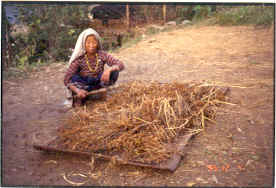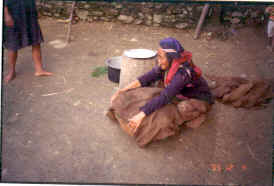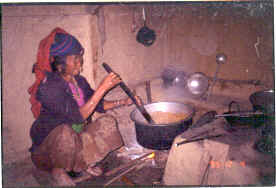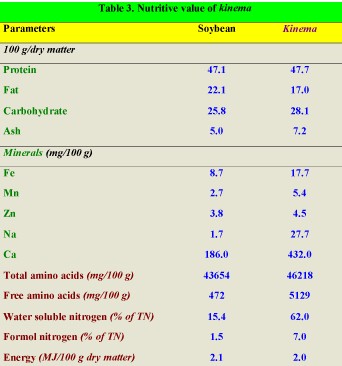| TRADITIONAL FERMENTED FOODS AND BEVERAGES
OF THE SIKKIM HIMALAYAS |

Kinema is one of the important components of diverse food culture of the ethnic
communities in the Eastern Himalayan regions of Nepal, the Darjeeling hills
and Sikkim of India, northeastern hills of India and Bhutan. Kinema is a
whole-soybean fermented food with sticky texture, gray tan coloured and
flavouresome. It is similar to
Japanese natto. The word kinema has been derived from ‘kinambaa’ of the
Limboo dialect (Limboo, being one of the major ethnic Nepali communities), “ki” means fermented and “nambaa” means flavour (Tamang,
2001). A kingdom of ‘Limbuwan’ (presently the eastern Nepal districts
of Therathum, Taplejung, Panchthar, Dhankuta, Ilam) had been established by
the Limboo earlier than 7th century and they ruled
independently till unification of Nepal in the 17th century.
Though there is no historical document on origin of kinema, yet it is
certain that among the Nepalis, the Limboo started production and
consumption of this unique fermented flavoursome soybean food. Unification
of Nepal, existence of mixed society of multiethnic communities and
migration of people from one place to another might have resulted in
diversification of kinema making and eating to other related Nepali
communities such as Rai, Tamang, Gurung, Mangar, etc. However, kinema is
still not popular among the Brahmin Nepalis. Other mountain ethnic
communities in the Eastern Himalayas now share the delicacy of kinema. The
Lepcha calls it satlyangser and the Bhutia, bari in Sikkim.
|
 
In
the Sikkim Himalayas, during preparation of kinema  (Fig 1-3), small-sized
(~ 6 mm) yellow coated seeds of local cultivars of soybeans are soaked in
spring water overnight and cooked by boiling until they can be pressed
easily. Excess water is drained off and seeds are cracked lightly by a
wood (Fig 1-3), small-sized
(~ 6 mm) yellow coated seeds of local cultivars of soybeans are soaked in
spring water overnight and cooked by boiling until they can be pressed
easily. Excess water is drained off and seeds are cracked lightly by a
wood en pestle (locally called muslo)
in a wooden mortar (locally called okhli)
to split the cotyledons, probably to accelerate the fermentation and
increase the surface area for aerobic spore-forming bacteria. Grits are
placed in a bamboo basket lined with locally grown fresh fern {Glaphylopteriopsis
erubescens (Well ex. Hook.) Ching} fronds, covered with a jute-bag and
left to ferment naturally at ambient temperatures (25-400 C)
for 2-3 days above earthen-oven kitchen. In some villages, about 1 % of
fresh firewood ash is added in the cooked soybeans during production. In
eastern Nepal, dark brown coated seeds of soybean are used to make kinema.
Instead of fern leaves, Ficus and banana eaves are used as wrapping en pestle (locally called muslo)
in a wooden mortar (locally called okhli)
to split the cotyledons, probably to accelerate the fermentation and
increase the surface area for aerobic spore-forming bacteria. Grits are
placed in a bamboo basket lined with locally grown fresh fern {Glaphylopteriopsis
erubescens (Well ex. Hook.) Ching} fronds, covered with a jute-bag and
left to ferment naturally at ambient temperatures (25-400 C)
for 2-3 days above earthen-oven kitchen. In some villages, about 1 % of
fresh firewood ash is added in the cooked soybeans during production. In
eastern Nepal, dark brown coated seeds of soybean are used to make kinema.
Instead of fern leaves, Ficus and banana eaves are used as wrapping  materials.
The rest of the method remain the same. Completion of
fermentation is
indicated by the appearance of
a white viscous mass and typical kinema flavour
with slight ammoniacal odour. Shelf life of fresh kinema is 2-3 days
during summer and a maximum of one week in winter without refrigeration.
Sun-dried kinema is stored for several months at room temperature.
Preparation of kinema varies from place to place and is still restricted
to household level. It is interesting to note that the mountain women using
their indigenous knowledge of food production exclusively prepare kinema. This unique indigenous knowledge of kinema-making has been
protected as hereditary right and passes from mother to daughter. materials.
The rest of the method remain the same. Completion of
fermentation is
indicated by the appearance of
a white viscous mass and typical kinema flavour
with slight ammoniacal odour. Shelf life of fresh kinema is 2-3 days
during summer and a maximum of one week in winter without refrigeration.
Sun-dried kinema is stored for several months at room temperature.
Preparation of kinema varies from place to place and is still restricted
to household level. It is interesting to note that the mountain women using
their indigenous knowledge of food production exclusively prepare kinema. This unique indigenous knowledge of kinema-making has been
protected as hereditary right and passes from mother to daughter.

Fig. Flow sheet of traditional method of Kinema production
practiced in Sikkim
|

|
 |
Kinema is eaten as a side-dish curry with boiled rice. Delicacy of kinema can be perceived by its appealing flavour and sticky texture. The most
common traditional recipe of kinema curry is cited in figure. Heat
vegetable oil in a fry pan and add chopped onions and fry till it becomes
tender. Add tomatoes and turmeric powder and fry for 2 min and fry fresh kinema, add salt, sliced green chilies and fry for 3-5 min. A little water
is poured to make a thick curry, and cook for 5-7 min. Kinema curry is
ready to serve with boiled rice. Sun-dried kinema is sometimes mixed with
leafy vegetable to make mixed curry as side dish.

|

|
 |
 Kinema production is an income generation means for some families. Kinema is sold in all local
periodical markets,
called
‘haats’, of these regions by rural women. Usually, it is sold by
volume taking in a small silver mug containing 150-200 g of kinema,
and packed in the leaves of Ficus
hookeriana, and then tied loosely by straw. Polybags are not used to
pack kinema. One kg of kinema costs about Rs. 30/-. On an average, 5 kg of kinema is sold by each seller in a local market with about 40 % of profit. This little profit they spend on children’s education and on domestic
expenses. This trade has been protected as hereditary right and passes
from mother to daughter. Though there is a good market for kinema, and moreover some rural women are
involved in this income
generation, kinema processing is
still restricted to individual households; there is no organized processing
unit or factory. Inexpensive and ready-to-use pulverized starter culture
of Bacillus subtilis has been developed for kinema production, which can be adopted to suit local conditions for more income
generation and is cost-effective (Tamang, 2000b). Kinema production is an income generation means for some families. Kinema is sold in all local
periodical markets,
called
‘haats’, of these regions by rural women. Usually, it is sold by
volume taking in a small silver mug containing 150-200 g of kinema,
and packed in the leaves of Ficus
hookeriana, and then tied loosely by straw. Polybags are not used to
pack kinema. One kg of kinema costs about Rs. 30/-. On an average, 5 kg of kinema is sold by each seller in a local market with about 40 % of profit. This little profit they spend on children’s education and on domestic
expenses. This trade has been protected as hereditary right and passes
from mother to daughter. Though there is a good market for kinema, and moreover some rural women are
involved in this income
generation, kinema processing is
still restricted to individual households; there is no organized processing
unit or factory. Inexpensive and ready-to-use pulverized starter culture
of Bacillus subtilis has been developed for kinema production, which can be adopted to suit local conditions for more income
generation and is cost-effective (Tamang, 2000b).
Picture: Kinema is sold at Lal market in Gangtok |
|
 |
 |
 Heat
resistant spore-forming bacterium Bacillus
subtilis, lactic acid bacteria
such as Enterococcus
faecium, and few types of
yeast like Candida parapsilosis and Geotrichum candidum have
been recovered from kinema.
However, Bacillus subtilis is
the dominant microflora in kinema fermentation,
followed by Enterococcus faecium. It is observed that rich microbial
diversity in various sources, particularly soybean, equipment and leaves as
wrapping materials harness indigenous microbiota for spontaneous
fermentation of kinema. Practice
of not cleaning up the mortar and pestle, and using fresh leaves as
wrapping materials by rural people, significantly correlate their
indigenous knowledge of ‘microbiology’ to preserve and supplement
microorganisms for spontaneous fermentation of kinema without using starter cultures. Heat
resistant spore-forming bacterium Bacillus
subtilis, lactic acid bacteria
such as Enterococcus
faecium, and few types of
yeast like Candida parapsilosis and Geotrichum candidum have
been recovered from kinema.
However, Bacillus subtilis is
the dominant microflora in kinema fermentation,
followed by Enterococcus faecium. It is observed that rich microbial
diversity in various sources, particularly soybean, equipment and leaves as
wrapping materials harness indigenous microbiota for spontaneous
fermentation of kinema. Practice
of not cleaning up the mortar and pestle, and using fresh leaves as
wrapping materials by rural people, significantly correlate their
indigenous knowledge of ‘microbiology’ to preserve and supplement
microorganisms for spontaneous fermentation of kinema without using starter cultures.
On
a protein-cost-per-kilogram basis, kinema is the cheapest source of plant protein compared to animal and dairy
products.
During kinema production, soya proteins,
 which have been denatured by cooking process, are hydrolyzed by
proteolytic enzymes produced by Bacillus
subtilis into peptides and amino acids enhancing digestibility.
Remarkable increase in water-soluble nitrogen, trichloroacetic
acid-soluble nitrogen contents, total amino acids, free amino acids and
mineral contents was observed during kinema fermentation, and
subsequently enriched the nutritional value of the product. Kinema contains (per 100 g dry matter) 48 g Protein, 17 g Fat, 28 g Carbohydrate and 2 MJ
Calorie (Sarkar et al., 1994; Tamang and Nikkuni, 1996; Tamang, 2000c). which have been denatured by cooking process, are hydrolyzed by
proteolytic enzymes produced by Bacillus
subtilis into peptides and amino acids enhancing digestibility.
Remarkable increase in water-soluble nitrogen, trichloroacetic
acid-soluble nitrogen contents, total amino acids, free amino acids and
mineral contents was observed during kinema fermentation, and
subsequently enriched the nutritional value of the product. Kinema contains (per 100 g dry matter) 48 g Protein, 17 g Fat, 28 g Carbohydrate and 2 MJ
Calorie (Sarkar et al., 1994; Tamang and Nikkuni, 1996; Tamang, 2000c).
|

|
|
 |
Kinema is similar to natto of Japan, chungkok-jang of Korea, thua-nao of Thialand, Pe-poke of Myanmar, turangbai of Meghalaya, aakhuni of
Nagaland, hawaijar of Manipur
and bekanthu of Mizoram. |
|

 (Fig 1-3), small-sized
(~ 6 mm)
(Fig 1-3), small-sized
(~ 6 mm) en pestle (locally called muslo)
in a wooden mortar (locally called okhli)
to split the cotyledons, probably to accelerate the fermentation and
increase the surface area for aerobic spore-forming bacteria. Grits are
placed in a bamboo basket lined with locally grown fresh fern {Glaphylopteriopsis
erubescens (Well ex. Hook.) Ching} fronds, covered with a jute-bag and
left to ferment naturally at ambient temperatures (25-400 C)
for 2-3 days above earthen-oven kitchen. In some villages, about 1 % of
fresh firewood ash is added in the cooked soybeans during production. In
eastern Nepal, dark brown coated seeds of soybean are used to make kinema.
Instead of fern leaves, Ficus and banana eaves are used as wrapping
en pestle (locally called muslo)
in a wooden mortar (locally called okhli)
to split the cotyledons, probably to accelerate the fermentation and
increase the surface area for aerobic spore-forming bacteria. Grits are
placed in a bamboo basket lined with locally grown fresh fern {Glaphylopteriopsis
erubescens (Well ex. Hook.) Ching} fronds, covered with a jute-bag and
left to ferment naturally at ambient temperatures (25-400 C)
for 2-3 days above earthen-oven kitchen. In some villages, about 1 % of
fresh firewood ash is added in the cooked soybeans during production. In
eastern Nepal, dark brown coated seeds of soybean are used to make kinema.
Instead of fern leaves, Ficus and banana eaves are used as wrapping  materials.
The rest of the method remain the same. Completion of
fermentation is
indicated by the appearance of
a white viscous mass and typical kinema flavour
with slight ammoniacal odour. Shelf life of fresh kinema is 2-3 days
during summer and a maximum of one week in winter without refrigeration.
Sun-dried kinema is stored for several months at room temperature.
Preparation of kinema varies from place to place and is still restricted
to household level. It is interesting to note that the mountain women using
their indigenous knowledge of food production exclusively prepare kinema. This unique indigenous knowledge of kinema-making has been
protected as hereditary right and passes from mother to daughter.
materials.
The rest of the method remain the same. Completion of
fermentation is
indicated by the appearance of
a white viscous mass and typical kinema flavour
with slight ammoniacal odour. Shelf life of fresh kinema is 2-3 days
during summer and a maximum of one week in winter without refrigeration.
Sun-dried kinema is stored for several months at room temperature.
Preparation of kinema varies from place to place and is still restricted
to household level. It is interesting to note that the mountain women using
their indigenous knowledge of food production exclusively prepare kinema. This unique indigenous knowledge of kinema-making has been
protected as hereditary right and passes from mother to daughter.


 Kinema production is an income generation means for some families. Kinema is sold in all local
periodical markets,
called
‘haats’, of these regions by rural women. Usually, it is sold by
volume taking in a small silver mug containing 150-200 g of kinema,
and packed in the leaves of Ficus
hookeriana, and then tied loosely by straw. Polybags are not used to
pack kinema. One kg of kinema costs about Rs. 30/-. On an average, 5 kg of kinema is sold by each seller in a local market with about 40 % of profit. This little profit they spend on children’s education and on domestic
expenses. This trade has been protected as hereditary right and passes
from mother to daughter. Though there is a good market for kinema, and moreover some rural women are
involved in this income
generation, kinema processing is
still restricted to individual households; there is no organized processing
unit or factory. Inexpensive and ready-to-use pulverized starter culture
of Bacillus subtilis has been developed for kinema production, which can be adopted to suit local conditions for more income
generation and is cost-effective (Tamang, 2000b).
Kinema production is an income generation means for some families. Kinema is sold in all local
periodical markets,
called
‘haats’, of these regions by rural women. Usually, it is sold by
volume taking in a small silver mug containing 150-200 g of kinema,
and packed in the leaves of Ficus
hookeriana, and then tied loosely by straw. Polybags are not used to
pack kinema. One kg of kinema costs about Rs. 30/-. On an average, 5 kg of kinema is sold by each seller in a local market with about 40 % of profit. This little profit they spend on children’s education and on domestic
expenses. This trade has been protected as hereditary right and passes
from mother to daughter. Though there is a good market for kinema, and moreover some rural women are
involved in this income
generation, kinema processing is
still restricted to individual households; there is no organized processing
unit or factory. Inexpensive and ready-to-use pulverized starter culture
of Bacillus subtilis has been developed for kinema production, which can be adopted to suit local conditions for more income
generation and is cost-effective (Tamang, 2000b).
 Heat
resistant spore-forming bacterium Bacillus
subtilis, lactic acid bacteria
such as Enterococcus
faecium, and few types of
yeast like Candida parapsilosis and Geotrichum candidum have
been recovered from kinema.
However, Bacillus subtilis is
the dominant microflora in kinema fermentation,
followed by Enterococcus faecium. It is observed that rich microbial
diversity in various sources, particularly soybean, equipment and leaves as
wrapping materials harness indigenous microbiota for spontaneous
fermentation of kinema. Practice
of not cleaning up the mortar and pestle, and using fresh leaves as
wrapping materials by rural people, significantly correlate their
indigenous knowledge of ‘microbiology’ to preserve and supplement
microorganisms for spontaneous fermentation of kinema without using starter cultures.
Heat
resistant spore-forming bacterium Bacillus
subtilis, lactic acid bacteria
such as Enterococcus
faecium, and few types of
yeast like Candida parapsilosis and Geotrichum candidum have
been recovered from kinema.
However, Bacillus subtilis is
the dominant microflora in kinema fermentation,
followed by Enterococcus faecium. It is observed that rich microbial
diversity in various sources, particularly soybean, equipment and leaves as
wrapping materials harness indigenous microbiota for spontaneous
fermentation of kinema. Practice
of not cleaning up the mortar and pestle, and using fresh leaves as
wrapping materials by rural people, significantly correlate their
indigenous knowledge of ‘microbiology’ to preserve and supplement
microorganisms for spontaneous fermentation of kinema without using starter cultures. which have been denatured by cooking process, are hydrolyzed by
proteolytic enzymes produced by Bacillus
subtilis into peptides and amino acids enhancing digestibility.
Remarkable increase in water-soluble nitrogen, trichloroacetic
acid-soluble nitrogen contents, total amino acids, free amino acids and
mineral contents was observed during kinema fermentation, and
subsequently enriched the nutritional value of the product. Kinema contains (per 100 g dry matter) 48 g Protein, 17 g Fat, 28 g Carbohydrate and 2 MJ
Calorie (Sarkar et al., 1994; Tamang and Nikkuni, 1996; Tamang, 2000c).
which have been denatured by cooking process, are hydrolyzed by
proteolytic enzymes produced by Bacillus
subtilis into peptides and amino acids enhancing digestibility.
Remarkable increase in water-soluble nitrogen, trichloroacetic
acid-soluble nitrogen contents, total amino acids, free amino acids and
mineral contents was observed during kinema fermentation, and
subsequently enriched the nutritional value of the product. Kinema contains (per 100 g dry matter) 48 g Protein, 17 g Fat, 28 g Carbohydrate and 2 MJ
Calorie (Sarkar et al., 1994; Tamang and Nikkuni, 1996; Tamang, 2000c).